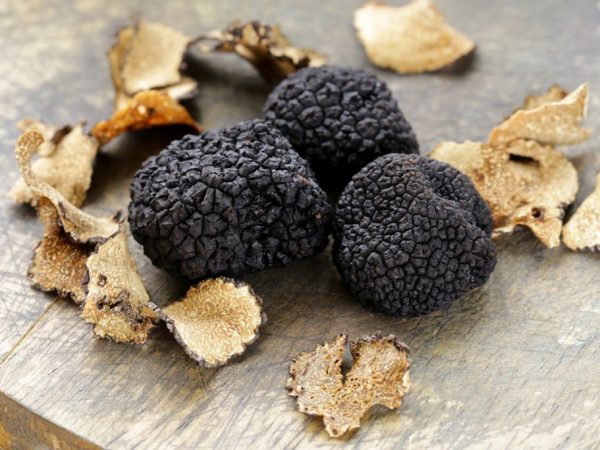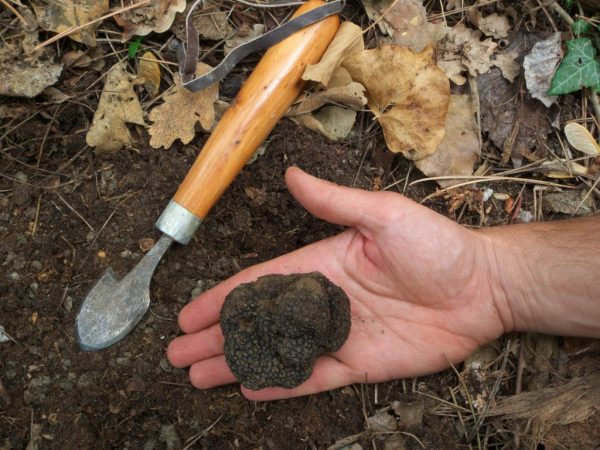Type of mushrooms Black truffle
There are several expensive types of mushrooms, among which the black truffle stands out for its taste. This type is classified as a gourmet one and is used in gourmet dishes. Finding a black truffle is not easy due to the way it grows.

Kind of mushrooms black truffle
Description of the mushroom
Black truffle (Tuber melanosporum) belongs to the Truffle family and Truffle genus. The mushroom is also called Perigord truffle, or black French. This revised name is due to the fact that most of the range falls on the French region of Perigord. This type is the most sophisticated and expensive.
Appearance
The mushroom has an external form of a tuber disproportionate in its structure. The body has 4 to 6 faces. The diameter of the tuber is 7-8 cm. The weight of one mushroom is up to 400 g. The color of the surface of the fruiting body depends on age. Young truffle is dark brown in color. Over time, the top layer turns charcoal black. If you press on the surface of the body, the color will turn dark orange.
The pulp is light, darkens over time from ripening spores and acquires a purple hue. The structure of the body is marble, with many white or light pink veins. The taste of the pulp is intense, characteristic with a chocolate note and light bitterness. The aroma is pronounced.
Microscopically small spores are oval or fusiform, strongly curved. The color of the spore powder is dark brown. Fruiting of the species lasts from early December to mid-March.
Places of growth
The Perigord black truffle grows not only in Perigord. Mushrooms of this species are found in other regions of France:
- Dordogne;
- Vaucluse;
- Gironde.
The species is also found in the north of Spain and Italy. China is the world's leader in the number of artificially grown black truffles. The Chinese counterpart is more common due to its low price. However, the quality of such mushrooms is significantly inferior to French ones.
Similar species
Besides the classic black truffle, there are other varieties with similar characteristics:
- Russian summer black truffle (Tuber aestivum): the fruit body reaches 12 cm in diameter, the mass of the fungus is up to 450 g. With age, the color of the pulp changes from white to gray-brown. The taste gives off nuts. Places of growth - Crimea, the Caucasus, the European part of Russia. The species grows under pine and oak trees. The fruiting period is from June to mid-October.
- Black Burgundy Truffle (Tuber mesentericum): this species is characterized by a rounded shape and weights up to 310 g. The diameter of the fruit body is up to 9 cm. The pulp has a light brown tint with a marble structure. The aroma contains notes of cocoa.
- Black winter truffle (Tuber brumale): the fruiting body is round, 7-20 cm in diameter. The mass of the mushroom reaches 120 g. The surface of the body has a purple hue and is covered with growths. The aroma is musky, pronounced. The fruiting period is early November - mid February. Requires hazel or linden for growth. Growing places - Italy, Ukraine and southwest Switzerland.
- Himalayan black truffle (Tuber himalayensis): fruit body usually weighing up to 50 g, with a pronounced nutty taste. Finding tubers is difficult due to their small size.
Growth features

The mushroom grows at a depth of 35 cm
Truffle belongs to marsupial mushrooms. Such species have the following growth characteristics:
- The edible body is in the ground, at a depth of 10 to 35 cm.
- The soil for growth must contain lime.
- Certain tree species are essential for the good development of a truffle.
Irina Selyutina (Biologist):
The mycelium of a truffle, regardless of the species, usually gives 3-7 fruiting bodies, which are arranged in a circle, forming a nest. When ripe, the soil rises above them, forming characteristic tubercles and this serves as a kind of signal for the truffle collectors. Gradually, the nests grow and with careful collection the "truffle" will give new fruiting bodies for a long time. It takes 3-4 months for a truffle to fully develop.
The black truffle species needs hazel or oak roots to form mycorrhiza. Other trees are not suitable for proper development.
The tree provides the truffle with the necessary complex of minerals, and the mycelium enhances the ability of the root system to absorb water and salt.
Composition and useful properties
The calorie content of the product is 25 kcal per 100 g. The composition of the mushroom:
- proteins - 3 g;
- fats - 0.5 g;
- carbohydrates - 2 g.
The low calorie content allows the use of black truffle during the diet.
Beneficial features:
- They improve metabolism in the body, lower cholesterol and blood sugar levels.
- Ascorbic acid reduces the risk of colon malfunction and aids in the absorption of iron and calcium.
- B vitamins improve the functioning of the endocrine system and adrenal glands.
Vitamin B3 present in the composition is responsible for the normal regeneration of the epidermis (the surface layer of the skin - the cuticle).
The most important property of the black truffle is its effect on the human reproductive system. It is believed that eating it cures impotence in men and increases a woman's chances of getting pregnant.
In nature, the mushroom is the orderly of the forest. Black truffle often grows near old trees, processing their roots. Also, the species protects the root system of healthy trees from late blight.
Contraindications to use
Truffle is not recommended to be added to the diet in the presence of stomach or intestinal ulcers. And also not recommended for children under 12 years old, pregnant and lactating women.
Contraindications also include individual intolerance to the product. If you have an allergic reaction to common mushrooms, it is better not to eat the truffle.
Representatives of the species can harm the environment. Where mycelium grows, other plants die from a lack of nutrients and water.
Collection rules

Finding mycelium is not easy
Collecting the highest quality black truffles requires special training and a helper animal. The best seekers of this species are pigs. They sense the smell of mushrooms at 20-25 m. The danger is the love of the animal for these "fruits" - pigs sometimes take off and tear the soil, harming the mycelium.
Also, specially trained dogs are used for searching. Training takes a lot of time - the puppies are given milk with the addition of truffle and are forced to look for boards with a mushroom smell. A bloodhound trained in this way is expensive.
Red flies will help to detect mycelium. They lay the larvae in truffle areas, so a large concentration of such insects indicates a mushroom clearing.
Irina Selyutina (Biologist):
As strange as it may seem to us, the inhabitants of the provinces of Périgord and Vaucluse use the practice of "hunting for flies" to collect truffles. It is based on the fact that the so-called. truffle flies (Helomyza gigantea, H. pallida, H. ustullata, H. tuberivora) lay their eggs in the soil near truffles. Their developing larvae feed on the tissues of the truffle. So years of these insects is an "indicator" of the presence of truffles in the area.
After finding them, it is important to carefully dig up and cut the mushroom so as not to damage the mycelium and the mushroom itself. It is better to tear the earth with gloved hands. The fruiting body is cut off with a thin knife.
Using black truffle
The species is extremely rarely used in everyday cooking due to its high cost. Truffle is used in haute French and Italian cuisine. The Perigord look is consumed fresh, with the addition of walnuts and honey. Also, this variety is used in salads and cuts.
A popular dish is truffle marinated in white wine, which is served thinly with fine alcoholic drinks.
Lower quality varieties are used to make sauces and marinades for meat. They are also placed in the filling of dough products along with minced rabbit.
The truffle has also found its own use in medicine. It is used for different purposes:
- The juice heals eye diseases.
- Powder from the fruit body of black truffle is used for compresses for gout and joint pain.
- Fresh mushroom is a powerful aphrodisiac.
Fruiting bodies are also used in cosmetology. In elite clinics, using masks based on black truffle, lighten the skin and remove pigmentation. Also, fruiting bodies help get rid of wrinkles and correct the contours of the face.
Growing features
To grow a species at home, you need to purchase seedlings of certain types of tree species and infect them with mycelium. The following tree species are suitable for growing the species:
- stone oak;
- English oak;
- common hazel.
For your information. Seedlings are very young plants that have just emerged from seeds.
After inoculation (infection), the seedlings are placed in a greenhouse, in which strict quarantine must be observed. The trees should be planted after 12 months, when the seedlings have reached 25 cm in height.
A soil with a high calcium and humus content is suitable for planting. It is also necessary not to forget about its acidity. Only a certain level of it will allow you to get the harvest of this mushroom. Ideally, pH = 7.5-7.9. Best grown in dry climates. The average ambient temperature in summer should not exceed + 25 ° С. Planting is carried out in the spring, after the end of frost and the onset of stable warm weather. The landing pattern is 5x4 m. The landing depth should be at least 75 cm.
The harvest in the first years will be small - 3-4 kg per hectare. Over time, the number of mushrooms will increase. 5 years after planting, with proper care, up to 20 kg of truffles are harvested.
Conclusion
The black truffle is a delicacy. The classic Perigord species is found in France, Italy and Spain, but some related species grow in Russia and the CIS countries.
The search for fruiting bodies is complicated by the peculiarities of their growth. The culture is actively used in cooking and medicine.



